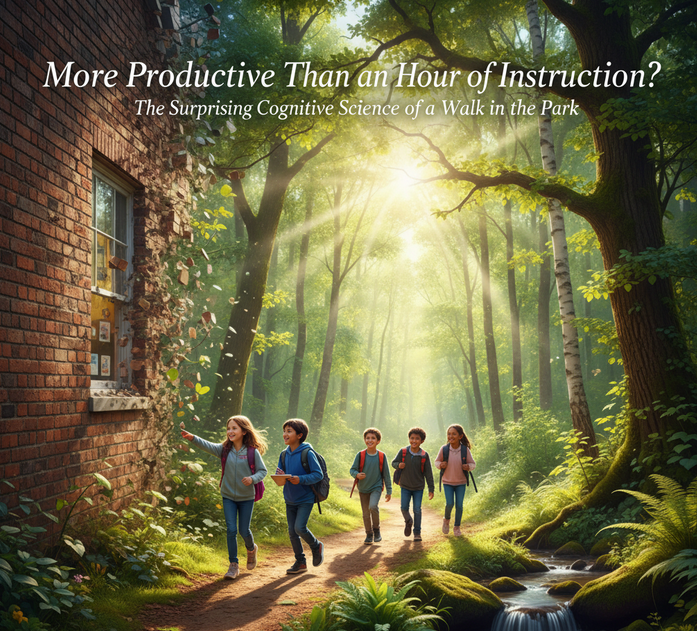More Productive Than an Hour of Instruction?
The Surprising Cognitive Science of a Walk in the Park

The capacity for intense focus in our students is a finite resource—a cognitive fuel tank that can, and does, run low. We see the results in the classroom: irritability, impatience, and a fraying of impulse control. But what if one of the most powerful tools for refueling that tank wasn't a new pedagogical strategy, but something far more fundamental?
Five years ago, I wrote about the profound impact that greenery can have on health and learning in The Influence of Greenery on Learning. When I recently listened to Dr. Marc Berman, Director of the Environmental Neuroscience Lab at the University of Chicago, expand on this research on the Many Minds podcast, it prompted me to revisit that post. I was humbled to realize how many of his foundational studies I had completely overlooked. This new understanding reveals that nature is not just an amenity, but a necessity for cognition.
At the start of the episode, Berman unpacks one of the theories I had very briefly mentioned on why greenery might be so rejuvenative: Attention Restoration Theory. According to Berman, the theory posits that our capacity for intense focus, or directed attention, is a finite resource—a cognitive fuel tank that can, and does, run low. When it’s depleted, we can see the results at home and in the classroom: irritability, impatience, and a fraying of impulse control.
Natural environments, on the other hand, engage our involuntary attention—the effortless, bottom-up engagement of our senses captured by the gentle rustling of leaves or the movement of light through the clouds, and it allows our depleted resources for directed, intense focus to restore themselves. Berman terms this “soft fascination.” This is wholly distinct from the “harsh fascination” of a chaotic urban scene, with its blaring horns and noise, which consumes our mental resources.
The cognitive benefits are significant. One of the studies that kickstarted Berman’s research showed a 20% improvement in cognitive performance after a walk in nature. This boost occurred even when participants didn't particularly enjoy the walk, demonstrating a powerful, mood-independent effect.
This research has profound implications for educational equity. A follow-up study found that individuals with major depressive disorder (MDD) see even more significant cognitive gains from a nature walk. Conversely, a walk in an urban environment can actually worsen their cognitive performance. This suggests that the lack of green space in many under-resourced communities can be actively harmful to our most vulnerable students. Access to restorative natural environments should therefore not be seen as a luxury, but as a prerequisite for equitable learning.
But what is it about nature that is so restorative? Berman’s explication identifies specific “active ingredients.” It turns out my hunch about fractals was on the right track. His team analyzed what they call low-level visual features to quantify what makes a scene feel “natural.”
Key among these are:
- Fractalness and Compressibility: Natural scenes have high “fractalness”—the repetition of similar patterns at different scales. This visual structure means they are also more “compressible,” like a JPEG file. Our brains find this informational efficiency less demanding to process, which frees up cognitive bandwidth.
- Curved Edges: Natural environments have a high density of non-straight, curved edges, whereas our built environments are dominated more by rigid, straight lines. These curves are not only easier on the eyes, but as one study found, they are also correlated with a viewer's tendency to reflect on deeper topics like their life's journey and spirituality.
Berman furthermore points to additional sensory qualities of nature that go beyond the mere visual:
- Auditory Stimuli: Brief exposure to natural sounds like birdsong, wind, or flowing water has been shown to improve cognitive performance when compared to urban noise.
- Olfactory Stimuli: The air itself carries restorative properties. The scent of damp earth after rain or the airborne chemicals (terpenes) emitted by pine trees can impact our well-being through the olfactory pathway.
For restoration to occur, according to Attention Restoration Theory, an environment must provide a sense of “Being Away” from daily pressures, have enough richness to get lost in (“Extent”), and support a person’s intentions (“Compatibility”). When these elements combine, the mind can truly recharge.
Now pivot that to an educational setting. Imagine a school that embodies these principles. Instead of a long, featureless corridor (no “Extent”), picture a hallway that curves and uses natural materials with fractal patterns like wood grain. Imagine the school itself providing a space for “Being Away” from stressors, a place for creativity and inspiration. By incorporating more trees and natural design principles into our schools, we can improve learning.
Thankfully, we don’t need a week-long immersion in a forest; studies confirm that a restorative “dose” of nature can be as short as 20 minutes. In a world of education reform obsessed with short-term metrics, this research demands we look at a more fundamental input: the physical environment itself. It forces us to ask a provocative question: could 6 hours of instruction plus 2 hours in a park be more productive than 8 straight hours behind a brick wall? The science increasingly suggests that the answer is yes.
For a full, fascinating dive into the research, I highly recommend listening to the entire podcast episode, and then poking around into some of Berman’s studies!
#greenery #learning #attention #neuroscience #schools #ecosystems #wellbeing #AttentionRestorationTheory #environmentalneuroscience #equity